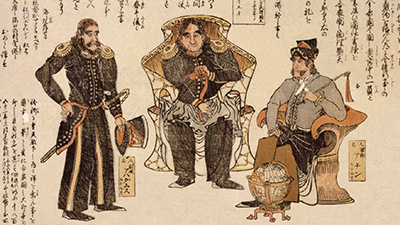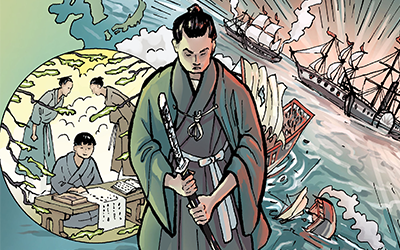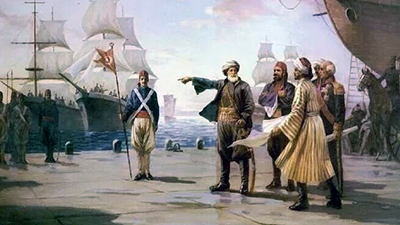Industrialization in Egypt and Japan
Teacher Resources
Driving Question: How did Egypt and Japan experience industrialization in the nineteenth century?
What happens when industrialization goes global? We’ll look at how Japan confronted this reality, and compare that country’s experience to Egypt’s. And we’ll see the unexpected phenomenon of deindustrialization, which hurt some regions (such as South Asia) while enriching others (such as Europe).
Learning Objectives:
- Evaluate how industrialization spread to Egypt and Japan.
- Use the historical thinking skill of comparison to explore how two different nations attempted to industrialize in the nineteenth century.
- Use a graphic biography to support, extend, or challenge the overarching narratives of this period.
Vocab Terms:
- debt
- deindustrialization
- export
- factory
- locomotion
- manufacturing
- reform
- tariff
Opener: Industrialization in Egypt and Japan
To teach this lesson step, refer to page 2 of the Lesson 5.4 Teaching Guide.
Our Openers and Closers Guide will provide more information about these short, but important, activities at the beginning and end of each lesson.
Would you stop the wheels of change if you could? Explore some hypotheticals to decide what—if anything—you’d do different if given the chance.
Japan’s Industrial Revolution
To teach this lesson step, refer to page 3 of the Lesson 5.4 Teaching Guide.
Comics in the classroom? The Three-Step Reading for Graphic Bios Tool is a great way to support learning.
Japan’s path to industrialization was unlike any other. Read the article to discover what made it unique, and then take a closer look at one key figure through a graphic biography.
-
Guiding Questions
-
Before you read
Preview the questions below, and then skim the article. Be sure to look at the section headings and any images.
While you read
Look for answers to these questions:
- Why was the arrival of American warships such a shock to the Japanese?
- What domestic problems did Matthew Perry’s arrival worsen?
- How was the political system after the restoration different from the previous political system?
- What steps did the reformers take to modernize Japan?
- Why was Japan’s victory over Russia so important?
After you read
Respond to the following questions:
- What effect did the Meiji Restoration have on communities?
- Was the Meiji Restoration a political revolution? Why or why not?
-
Guiding Questions
-
Before you read
Preview the questions below, and then skim the comic, paying attention to things like prominent colors, shapes, and types of text and fonts. How do you know where to start and in which direction to read? What’s in the gutters (the space between panels)? Who or what is the focus of the comic?
While you read
Look for answers to these questions:
- What were Iwasaki Yatarō’s origins?
- Why did many in late nineteenth-century Japan want to industrialize?
- What did Iwasaki Yatarō himself do, and how was he regarded by people in Nagasaki?
- What do you think is the meaning of the quote from Isawaki’s biographer?
- How does the author use art to represent changes in both Japan and Isawaki in this biography?
After you read
Respond to this question: How does this biography of Iwasaki Yatarō support, extend, or challenge what you have learned about industrialization in Japan specifically, and about the impact of industrialization on people and societies more generally?
Industrialization in Egypt
To teach this lesson step, refer to page 5 of the Lesson 5.4 Teaching Guide.
Check out our Reading Guide to learn about the Three-Step Reading approach.
This Comparison One-Pager is your one-stop resource for this fundamental historical thinking skill.
How did industrialization take different forms around the world? Explore Egypt’s unique path in the article, then compare what you’ve learned about Egypt and Japan in the activity.
-
Guiding Questions
-
Before you read
Preview the questions below, and then skim the article. Be sure to look at the section headings and any images.
While you read
Look for answers to these questions:
- What steps did Muhammad Ali take to modernize Egypt?
- European banks loaned lots of money to help Muhammad Ali modernize Egypt. Why was this a bad thing for Egypt?
- What are the three explanations for this failure?
- How did some Islamic scholars react to Egypt’s failures?
After you read
Respond to these questions: Which of the three explanations given for the failure of Egypt’s industrialization is most convincing to you? Why?
Closer: Industrialization in Egypt and Japan
To teach this lesson step, refer to page 9 of the Lesson 5.4 Teaching Guide.
Check out the OER Project Activities Guide for a review of the various activities that help students engage with World History.
You’ve learned about the different paths to industrialization experienced in Egypt and Japan. In this short activity, you’ll imagine yourself in the shoes of different people in those countries.







